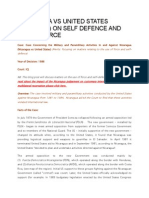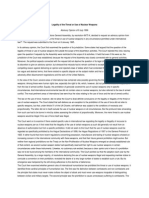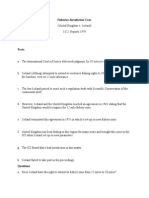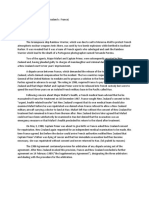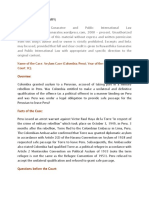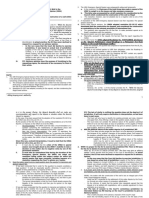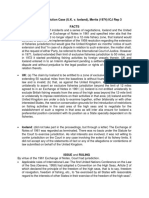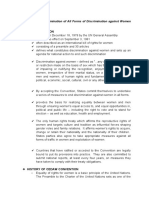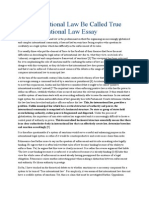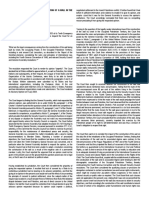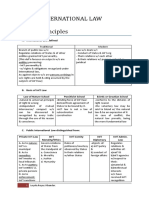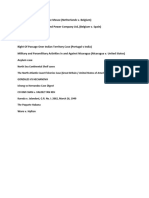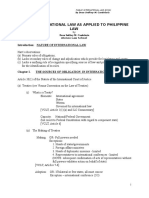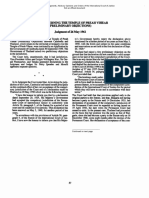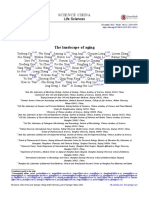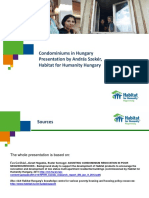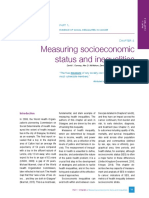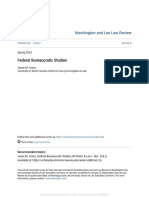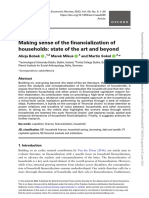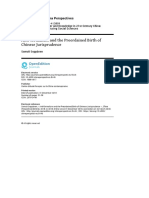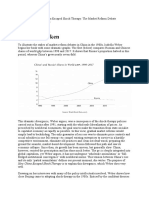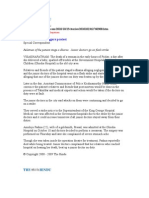1cambodia v. Thailand
1cambodia v. Thailand
Uploaded by
Maximus L MadusCopyright:
Available Formats
1cambodia v. Thailand
1cambodia v. Thailand
Uploaded by
Maximus L MadusOriginal Description:
Original Title
Copyright
Available Formats
Share this document
Did you find this document useful?
Is this content inappropriate?
Copyright:
Available Formats
1cambodia v. Thailand
1cambodia v. Thailand
Uploaded by
Maximus L MadusCopyright:
Available Formats
1.
Briefly what was the Full title of case, year and citation Case concerning The Temple of Preah Vihear(Cambodia v. Thailand), Prliminary Objections, Judgment of 26 May 1961. 2. interpretation issue - ie what provision of what treaty? and quote it The interpretation issue is: Article 36 of the Statute of the Court, and the Declaration of 20 May 1950 and 9 September 1957 by which Thailand and Cambodia respectively recognize the jurisdiction of the ICJ as well as the General Act for the Pacific settlement of the International Dispute of 26 September 1928. Proceedings in the case concerning the Temple of Preah Vihear(Preliminary Obejection) between Cambodia and Thailand, which relates the territorial sovereignty over the Temple of Preah Vihear, were instituted by an Application of Cambodia dated 30 September 1953. The Government of Thailand raised two preliminary objections to the jurisdiction of the Court. 1 On behalf of Gov. of Cambodia: "May it please the Court to adjudge and declare, whether the Kingdom of Thailand appears or not: (1) that the Kingdom of Thailand is under an obligation to withdraw the detachments of armed forces it has stationed since 1954 in the ruins of the Temple of Preah Vihear; (2) that the territorial sovereignty over the Temple of Preah Vihear belongs to the Kingdom of Cambodia"; In the Memorial, on the part of Cambodia: "May it please the Court to adjudge and declare, whether the Kingdom of Thailand appears or not: (1) that the Kingdom of Thailand is under an obligation to withdraw the detachments of armed forces it has stationed since 1954 in the ruins of the Temple of Preah Vihear; (2) that the territorial sovereignty over the Temple of Preah Vihear belongs to the Kingdom of Cambodia";2 In the reply, Thailand: "May it please the Court: I.To reject the submissions presented by the Kingdom of Thailand in its Counter-Memorial, subject, in particular, to the presentation, if necessary, of any other grounds for the rejection of any further submissions that may be presented by the Kingdom of Thailand;
Case concerning The Temple of Preah Vihear(Cambodia v. Thailand), Preliminary Objections, Judgment of 26 May 1961; Summary of Judgment, p.57.
2
Id., p.20.
II.To find in favour of the submissions contained in its Application instituting proceedings and in its Memorial. 3.What did the court suggest was its approach to interpretation in the case? Quote what the court said it was doing (eg normal meaning etc) The Court approached the question on interpretation by expressly articulating the canon of interpretation underlying its own jurisprudence. Accordingly, the Court assigns words the meaning which they naturally have in their particular context in which they occur. (t)he Court must apply its normal canons of interpretation, the first of which, according to the established jurisprudence of the Court, is that words are to be interpreted according to their natural and ordinary meaning in the context in which they occur: if the 1950 Declaration is considered in this way, it can have no other sense or meaning than as an acceptance of the compulsory jurisprudence of the present Court, for there was no other Court to which it can have related.3 4.What was the result (very briefly) By its Judgment of 26 May 1961, the Court rejected the first preliminary objection of the Government of Thailand and found that it had jurisdiction to adjudicate upon the dispute submitted to it on 6 October 1959 by the Application of the Government of Cambodia. By Order of the same date, the Court fixed the time-limits for the further pleadings. The case became ready for hearing on the filing of the last pleading on 2 February 1962. 5.Did the court took actually use the approach that it said it was doing? Ie identify what approach he court said it was taking and then analyse what approach it actually The Court was called to consider and decide whether it has competence or not over the territorial sovereignty of Thailand. Having determined that there is solely the validity of Thailands Declaration that is in issue in the present proceeding, the Court proceeds its own interpretation of the 1950 Declaration relating to the decision in the Israel v. Bulgaria case, as Thailand based the alleged effect on Thailands 1950 Declaration of the conclusion reached by the Court in this case. By rejecting the view of Thailand that the decision in Israel v. Bulgaria case has the consequences concerning the effect of Thailands 1950 Declaration, the Court considers that it must interpret the Thailands 1950 Declaration on its own merits, and without any preconception of an a priori4 kind, in order to determine what is its real meaning and effect if that Declaration is read as a whole and in the light of its known purpose, which has never been in doubt.Thus, the Court approaches the question of interpretation by applying its normal canons of interpretation, the first of which, according to the established jurisprudence of the Court, is that words are to be interpreted according to their natural and ordinary meaning in the context in which
Case concerning The Temple of Preah Vihear(Cambodia v. Thailand ), Preliminary Objections, Judgment of 26 May 1961; Summary of Judgment, p.32. 4 Id, p. 32.
they occur.5The Court approaches a textual interpretation of the 1950 Declaration, treating the terms in their contextual meaning, considering the text sufficiently clear as to demonstrate the intention of the parties. Also, the Court adopts a teleological interpretation of the 1950 Thailands Declaration, reading it in the light of its object and purpose, as to find the Thailands intention to be part of the Statute of the Court, which in the view of the Court it has never been in doubt. Thus the Court is consistent with itself by approaching the textualist method of interpretation on its entire reasoning as it established, and with its normal canon of interpretation and practice. 6 . Identify how this case builds on your knowledge of the court's approach so far This is a case when the Court expressly affirms principles of treaty interpretation, presaging article 31 of the Vienna Convention. The Court followed the practice of the PCIJ adopting the textualist method of interpretation as it found the text of the agreement sufficiently clear as to not rise unreasonable, absurd or self- contradictory result. In doing so, and in support of the textual approach, the Court invokes its own jurisprudence as relevant tool to strengthen the interpretation of the meaning of the words in their particular context. Nevertheless, the Court states that words and phrases must not always be interpreted in a purely literal way.6 And that this principle did not apply where it would lead to something unreasonable or absurd. 7In my view, the Court adopted more than a literal interpretation of the terms of the provision. It resorts to a teleological interpretation of the 1950 Thailands Declaration, as the Court felt to look at the document in a larger perspective, that of the object and purpose for it was concluded, in order to confirm the result it already reached. So the Court felt to inquire in depth the agreement to confirm the real intention of Thailand as acceptant of the International Courts jurisdiction. The Court seems not only to stop at extracting through an ordinary meaning and teleological approach of interpretation the intention of Thailand in accepting the ICJ jurisdiction, but also to demonstrate its obvious intention showed by the terms of the provisions Declaration as they are expressly provided. And that these terms leave no room of confusion for Thailand as being part of the Statute of the Court, and therefore susceptible of acceptance the compulsory jurisdiction of it: (i)f the 1950 Declaration is considered in this way, it can have no other sense or meaning than as an acceptance of the compulsory jurisprudence of the present Court, for there was no other Court to which it can have related.8 Further, in the light of a textualist and also a teleological interpretation, I see that the Court successfully demonstrated the intention of Thailand to accept the Courts jurisdiction, and that the Thailands objection to it, could only be justified as its intention to avoid it: (i)f a literal reading, part of Thailands Declaration had, ex post and because of the decision of the Court in the Israel v. Bulgaria, to be considered as a purported acceptance of the jurisdiction, of a defunct Court, this would be in clear contradiction to the reference in another part of a Declaration to Article 36, paragraph 4, of the Statute(and via that paragraph 2 and 3), which clearly evidenced acceptance of the jurisdiction of the present Court, and in contradiction also with the fact
5 6
Id, p. 32. Id, p.32. The Anglo-Iranian Oil Co. case, ICJ Report 1952, p.104. 7 Id. The Postal Service in Danzing( P.C.I.J., Series B, No. II, p.39 8 Case concerning The Temple of Preah Vihear(Cambodia v. Thailand ), Preliminary Objections, Judgment of 26 May 1961; Summary of Judgment, p.32.
that a communication under paragraph 4 could only relate to the present Court.9It follows for the Court to infer from this that (t)he remainder of the Declaration must be construed in the light of that cardinal fact, in the general context of the Declaration. 10 Given the fact that the interpretation of treaties is an important function of an international court, in my view, the position of the Court in the present case was strongly governed by its intention to underline the importance of the textual approach as the basic principle in treaty interpretation and the importance of not departure of it, as a certain way of avoiding the vaguesnes in the policy of treaty interpretation (Which would allow a party to eschew adjudication of the Court even if signed a treaty providing for such jurisdiction). Also, by following the practice of the PCIJ, the ICJ underlines the principles of international law, revealing an already existing path in the policy of treaty interpretation, which aims both to solve the problems that appear in international relations between States and to prevent disputes from arising.
One of the most controversial issues in the judicial settlement of disputes before the International Court of Justice (ICJ) is the relationship between the scope of the jurisdiction conferred on the Court and the law applicable to the dispute. When, in particular, the Court possesses jurisdiction under a compromissory clause of a treaty, the issue arises, in dispute settlement on the interpretation and application of that treaty, as to whether the treaty is the only law applicable. This question is easily solved when
10
Id., p.33. Id, p.34.
You might also like
- Preah Vihear Temple CaseDocument21 pagesPreah Vihear Temple CaseVishwanathan SubramaniamNo ratings yet
- Nicaragua Vs United States Case BriefDocument12 pagesNicaragua Vs United States Case Briefseventhwitch100% (1)
- Temple of Preah Vihear - Cambodia v. ThailandDocument5 pagesTemple of Preah Vihear - Cambodia v. ThailandTippy Dos Santos100% (2)
- State v. EbrahimDocument1 pageState v. EbrahimJayson100% (1)
- Lotus CaseDocument5 pagesLotus Caseashutosh100% (1)
- Cases - Treaties FullDocument20 pagesCases - Treaties FullLouem GarceniegoNo ratings yet
- S.S. LotusDocument3 pagesS.S. LotusRhev Xandra Acuña100% (1)
- Asylum CaseDocument5 pagesAsylum Casejrmc1991100% (1)
- Corfu Channel Case - HJMBDocument2 pagesCorfu Channel Case - HJMBHoney Joy MBNo ratings yet
- Cambodia v. ThailandDocument2 pagesCambodia v. Thailandvendetta scrubNo ratings yet
- Legality of Nuclear Weapons Case DigestDocument2 pagesLegality of Nuclear Weapons Case DigestJustine Bette ParroneNo ratings yet
- Case Concerning Armed Activities On The Territory of The CongoDocument9 pagesCase Concerning Armed Activities On The Territory of The CongoSheryll Aleth BaccayNo ratings yet
- Legality of The Use by A State of Nuclear Weapons in Armed ConflictDocument2 pagesLegality of The Use by A State of Nuclear Weapons in Armed ConflictVikki AmorioNo ratings yet
- Tadic CaseDocument3 pagesTadic CaseFloramie RomeroNo ratings yet
- PIL Exam NotesDocument16 pagesPIL Exam NotesDumakude GcabasheNo ratings yet
- Maritime Delimitation in The Area Between Greenland and Jan MayenDocument10 pagesMaritime Delimitation in The Area Between Greenland and Jan MayenAnna Marie DayanghirangNo ratings yet
- Corfu Channel CaseDocument8 pagesCorfu Channel CaseXyra Krezel GajeteNo ratings yet
- Case Concerning The Temple of Preah Vihear - Cambodia v. ThailandDocument3 pagesCase Concerning The Temple of Preah Vihear - Cambodia v. ThailandRoberts SamNo ratings yet
- Bill of RightsDocument6 pagesBill of RightsHarshSuryavanshiNo ratings yet
- Cambodia v. Thailand G.R. No. ??? - 1962 - Ur Mom Digest By: Rando Petitioner: Cambodia Respondent: Thailand Recit-Ready: FactsDocument3 pagesCambodia v. Thailand G.R. No. ??? - 1962 - Ur Mom Digest By: Rando Petitioner: Cambodia Respondent: Thailand Recit-Ready: FactsKobe Lawrence VeneracionNo ratings yet
- Public International Law Project Custom As A Source of International LawDocument17 pagesPublic International Law Project Custom As A Source of International LawVicky DNo ratings yet
- Fisheries Jurisdiction CaseDocument4 pagesFisheries Jurisdiction CaseRoe DanNo ratings yet
- Public International LawDocument6 pagesPublic International LawEllis DavidsonNo ratings yet
- Rainbow Warrior (New Zealand v. France) 1990Document4 pagesRainbow Warrior (New Zealand v. France) 1990Pierre AlvizoNo ratings yet
- Treaties - Public International Law Group AssignmentDocument17 pagesTreaties - Public International Law Group AssignmentKagi MogaeNo ratings yet
- Columbia Vs Peru Asylum CaseDocument7 pagesColumbia Vs Peru Asylum CasePeperoniiNo ratings yet
- Legal Consequences of A Construction of A Wall (2004)Document4 pagesLegal Consequences of A Construction of A Wall (2004)Cristelle Elaine ColleraNo ratings yet
- Fisheries Jurisdiction Case DigestDocument3 pagesFisheries Jurisdiction Case DigestReyar SenoNo ratings yet
- Air Carriers Liability in Cases of DelayDocument17 pagesAir Carriers Liability in Cases of Delayadityaprakoso100% (1)
- The Reparations Case, ICJ Rep. 1949, P. 174Document19 pagesThe Reparations Case, ICJ Rep. 1949, P. 174Shashank Sinha100% (1)
- Development of Delimitation by ICJDocument14 pagesDevelopment of Delimitation by ICJNeeleash Ganta100% (1)
- The Sources of International LawDocument1 pageThe Sources of International LawMika RainmanNo ratings yet
- Nicaragua Vs United StatesDocument33 pagesNicaragua Vs United Statespatricia.aniyaNo ratings yet
- Asylum Case (Summary) - Public International LawDocument8 pagesAsylum Case (Summary) - Public International LawJared LibiranNo ratings yet
- Temple of Preah VihearDocument1 pageTemple of Preah VihearPallavi SupehiaNo ratings yet
- Prosecutor Vs TadicDocument4 pagesProsecutor Vs TadicBenjamin Joseph GeronimoNo ratings yet
- The Case of The S.S. Lotus France v. TurkeyDocument3 pagesThe Case of The S.S. Lotus France v. TurkeyJ AquipelNo ratings yet
- (Cedaw) The Convention: Convention On The Elimination of All Forms of Discrimination Against WomenDocument9 pages(Cedaw) The Convention: Convention On The Elimination of All Forms of Discrimination Against WomenShannon Gail MaongsongNo ratings yet
- Colombia Vs Peru ICJ's RulingDocument4 pagesColombia Vs Peru ICJ's RulingShane Marie CanonoNo ratings yet
- Can International Law Be Called True Law International Law EssayDocument3 pagesCan International Law Be Called True Law International Law EssayAngna DewanNo ratings yet
- 2 North Sea Continental Shelf CasesDocument4 pages2 North Sea Continental Shelf CasesReah CrezzNo ratings yet
- Legal Consequences of The Construction of A Wall in The Occupied Palestinian TerritoryDocument2 pagesLegal Consequences of The Construction of A Wall in The Occupied Palestinian TerritoryElaiza Jamez PucateNo ratings yet
- Public International LawDocument34 pagesPublic International Lawmary grace banaNo ratings yet
- SS Lotus Case (France Vs Turkey)Document3 pagesSS Lotus Case (France Vs Turkey)Jessica PulgaNo ratings yet
- Islands of Palmas CaseDocument2 pagesIslands of Palmas CaseIvanheck GatdulaNo ratings yet
- PIL DigestDocument52 pagesPIL DigestAly ComiaNo ratings yet
- 2.1. The SS Lotus CaseDocument63 pages2.1. The SS Lotus CaseMichelle de los SantosNo ratings yet
- Hungary Vs SlovakiaDocument9 pagesHungary Vs SlovakiaGlo Allen CruzNo ratings yet
- 035 - Anglo Norwegian Fisheries CaseDocument8 pages035 - Anglo Norwegian Fisheries CaseBianca DeslateNo ratings yet
- 2 Interhandel Case (Ferrer) PDFDocument3 pages2 Interhandel Case (Ferrer) PDFMatt LedesmaNo ratings yet
- The Case of SS Lotus - France v. TurkeyDocument2 pagesThe Case of SS Lotus - France v. TurkeyPopeyeNo ratings yet
- Advisory Opinion On Nuclear WeaponDocument33 pagesAdvisory Opinion On Nuclear WeaponPhan Thị Yến NhiNo ratings yet
- Candelaria PIL Pre-Bar 2014Document66 pagesCandelaria PIL Pre-Bar 2014Karen Gina100% (3)
- Lotus CaseDocument3 pagesLotus CaseMie TotNo ratings yet
- Cambodia V ThailandDocument1 pageCambodia V ThailandLarissaNo ratings yet
- Fundamental Principles of International Economic LawDocument9 pagesFundamental Principles of International Economic LawTrupti JagtapNo ratings yet
- Armed Activities On The Territory of The Congo (DR Congo v. Uganda)Document4 pagesArmed Activities On The Territory of The Congo (DR Congo v. Uganda)Dane Nuesa100% (1)
- J R Robert Real - Feu - Introduction To Public International Law SyllabusDocument13 pagesJ R Robert Real - Feu - Introduction To Public International Law SyllabusPAULA CruzNo ratings yet
- Case Concerning The Tempile of Preah Vihear (Preliminary Obje :tions) of MayDocument2 pagesCase Concerning The Tempile of Preah Vihear (Preliminary Obje :tions) of MayKorina MarawisNo ratings yet
- Preliminar Y Objections of The Government of Thailand X. On The 6th October, 1959 The Governrnent of The KingdomDocument39 pagesPreliminar Y Objections of The Government of Thailand X. On The 6th October, 1959 The Governrnent of The KingdomTien Anh TranNo ratings yet
- Introduction: Law, Populism, and The Political in Semi-Peripheral Central and Eastern EuropeDocument26 pagesIntroduction: Law, Populism, and The Political in Semi-Peripheral Central and Eastern EuropeMaximus L MadusNo ratings yet
- Lawreview 4408 PargendlerDocument56 pagesLawreview 4408 PargendlerMaximus L MadusNo ratings yet
- Review Carte Tim BarleyDocument4 pagesReview Carte Tim BarleyMaximus L MadusNo ratings yet
- The Landscape of Aging: Science ChinaDocument101 pagesThe Landscape of Aging: Science ChinaMaximus L MadusNo ratings yet
- Etude HungaryDocument24 pagesEtude HungaryMaximus L MadusNo ratings yet
- Yochai Benkler Practicalanarchism FinalDocument39 pagesYochai Benkler Practicalanarchism FinalMaximus L MadusNo ratings yet
- 14 - IARC - SP N 168 - Chapter 4Document12 pages14 - IARC - SP N 168 - Chapter 4Maximus L MadusNo ratings yet
- SSRN Id4458504Document68 pagesSSRN Id4458504Maximus L MadusNo ratings yet
- 321-Article Text-1293-2-10-20200811Document13 pages321-Article Text-1293-2-10-20200811Maximus L MadusNo ratings yet
- Green Capitalism Accepted 180722Document30 pagesGreen Capitalism Accepted 180722Maximus L MadusNo ratings yet
- Wiley Law and Society AssociationDocument23 pagesWiley Law and Society AssociationMaximus L MadusNo ratings yet
- Mwad029 Financialization EuropeDocument26 pagesMwad029 Financialization EuropeMaximus L MadusNo ratings yet
- Chinaperspectives 8446Document9 pagesChinaperspectives 8446Maximus L MadusNo ratings yet
- Turgeon, Lynn - What Would Keynes Think of Shock Therapy - by Robert Skidelsky (1996)Document5 pagesTurgeon, Lynn - What Would Keynes Think of Shock Therapy - by Robert Skidelsky (1996)Maximus L MadusNo ratings yet
- Why Judicial Control of Price Terms in Consumer Contracts Might Not Always Be The Right Answer - Insights From Behavioural Law and EconomicsDocument37 pagesWhy Judicial Control of Price Terms in Consumer Contracts Might Not Always Be The Right Answer - Insights From Behavioural Law and EconomicsMaximus L MadusNo ratings yet
- C 1 A G D P R: Elettra BiettiDocument76 pagesC 1 A G D P R: Elettra BiettiMaximus L MadusNo ratings yet
- Gabor European Derisking State-1Document30 pagesGabor European Derisking State-1Maximus L MadusNo ratings yet
- Fragmentation Outline KoskenniemiDocument10 pagesFragmentation Outline KoskenniemiMaximus L MadusNo ratings yet
- Isabella Weber Review CarteDocument8 pagesIsabella Weber Review CarteMaximus L MadusNo ratings yet
- 13082-Article Text-10609-1-10-20161011Document8 pages13082-Article Text-10609-1-10-20161011Maximus L MadusNo ratings yet
- India 1999 PT Wto Inerprettaion CorolaryDocument41 pagesIndia 1999 PT Wto Inerprettaion CorolaryMaximus L MadusNo ratings yet
- Short Note On Question TagsDocument2 pagesShort Note On Question TagsDebaleena DuttaNo ratings yet
- G.R. No. 170606 November 23, 2007 LCK Industries Inc., Chiko Lim and Elizabeth T. Lim, Petitioners, Planters Development Bank, RespondentDocument76 pagesG.R. No. 170606 November 23, 2007 LCK Industries Inc., Chiko Lim and Elizabeth T. Lim, Petitioners, Planters Development Bank, RespondentlazylawatudentNo ratings yet
- How To Start A Real Estate Company in Nigeria - Youth EntrepreneurshipDocument8 pagesHow To Start A Real Estate Company in Nigeria - Youth EntrepreneurshipsolomonfisaacNo ratings yet
- The Warehouse Receipts LawDocument62 pagesThe Warehouse Receipts LawPingotMagangaNo ratings yet
- Heirs of Cabais v. CA, GR 106314-15Document6 pagesHeirs of Cabais v. CA, GR 106314-15Anna NicerioNo ratings yet
- Patient's Death Triggers Protest: Date:23/10/2010 URLDocument2 pagesPatient's Death Triggers Protest: Date:23/10/2010 URLNilima KhapardeNo ratings yet
- Night Auditor Check ListDocument2 pagesNight Auditor Check Listsashi suryaniNo ratings yet
- United States v. Henrry Lozano, 4th Cir. (2014)Document4 pagesUnited States v. Henrry Lozano, 4th Cir. (2014)Scribd Government DocsNo ratings yet
- Completing The Accounting CycleDocument52 pagesCompleting The Accounting CycleHEM CHEA100% (2)
- Internship Report of Askari BankDocument109 pagesInternship Report of Askari BankharisNo ratings yet
- Id Latest 2022Document3 pagesId Latest 2022mario curimaoNo ratings yet
- Medneg Chapter 1Document120 pagesMedneg Chapter 1Buknoy PinedaNo ratings yet
- Designation LetterDocument2 pagesDesignation LetterbabyroseNo ratings yet
- Sartell City Council Agenda and Packet 06.26.23Document208 pagesSartell City Council Agenda and Packet 06.26.23inforumdocsNo ratings yet
- Applied PhysicsDocument5 pagesApplied Physicsahmad irtisamNo ratings yet
- Hot Springs 07 CRPF Veer GathaDocument36 pagesHot Springs 07 CRPF Veer GathaAshyo MaanNo ratings yet
- West Bengal IPS ListDocument2 pagesWest Bengal IPS ListprobirparuiNo ratings yet
- 1445606825-Factsheet 2Document4 pages1445606825-Factsheet 2jonas msigalaNo ratings yet
- Wholesale AppDocument17 pagesWholesale AppKecamatan CiomasNo ratings yet
- 2.offer and AcceptanceDocument34 pages2.offer and AcceptanceBhavtosh MariyaNo ratings yet
- Maldives: Rules, Regulations & Formalities The New NormalDocument15 pagesMaldives: Rules, Regulations & Formalities The New NormalRishijit PanigrahiNo ratings yet
- (G.R. No. 521518. International Harwood V UPDocument13 pages(G.R. No. 521518. International Harwood V UPRogie ToriagaNo ratings yet
- Has Devolution Worked Essay Collection FINALDocument180 pagesHas Devolution Worked Essay Collection FINALBdu MV100% (1)
- RMO No. 27-2016Document5 pagesRMO No. 27-2016Romer LesondatoNo ratings yet
- Cabanlig vs. Sandiganbayan, 464 SCRA 324, July 28, 2005Document20 pagesCabanlig vs. Sandiganbayan, 464 SCRA 324, July 28, 2005Ken ChaseMasterNo ratings yet
- Superannuation TPD Claims Gerard Malouf PartnersDocument6 pagesSuperannuation TPD Claims Gerard Malouf PartnersUni TabberNo ratings yet
- Intelectual Property Law RA 8293 1Document5 pagesIntelectual Property Law RA 8293 1Alfred Joseph ZuluetaNo ratings yet
- ExempDocument1 pageExempFiaz Ahmed LoneNo ratings yet
- Chapter 10 Section 4 Crossword PuzzleDocument5 pagesChapter 10 Section 4 Crossword PuzzleMelissa ClubbNo ratings yet
- Mr. Jinnah SpeechDocument2 pagesMr. Jinnah SpeechRohanNo ratings yet

